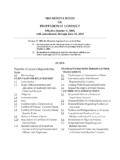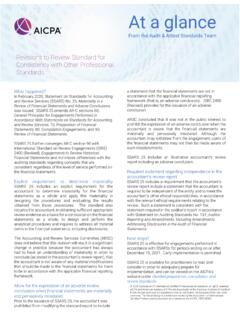Transcription of 1. THE LANGUAGE OF MATHEMATICS
1 1. THE LANGUAGE OF MATHEMATICSa hypotheticalsituationImagine the following scenario: you re in math class, and the instructor passesa piece of paper to each student. It is announced that the paper containsStudyStrategies for Students of MATHEMATICS ; you are to read it and make glancing at the paper, however, you observe that it is written in a foreignlanguage that you do not understand!the importanceof languageIs the instructor being fair? Of course not. Indeed, the instructor is probablytrying to make a point. Although theideasin the paragraph may be simple,there is no access to the ideas without a knowledge of thelanguagein which theideas are expressed.
2 This situation has a very strong analogy in frequently have trouble understanding mathematical ideas: not neces-sarily because the ideas are difficult, but because they are being presented in aforeign LANGUAGE the LANGUAGE of ofthe languageof mathematicsThe LANGUAGE of MATHEMATICS makes it easy to express the kinds of thoughtsthat mathematicians like to express. It is: precise (able to make very fine distinctions); concise (able to say things briefly); powerful (able to express complex thoughts with relative ease).The LANGUAGE of mathematicscan be learned, but requires the efforts needed tolearn any foreign LANGUAGE .
3 In this book, you will get extensive practice withmathematical LANGUAGE ideas, to enhance your ability to correctly read, write,speak, and understand LANGUAGE has its vocabulary (the words), and its rules for combining thesewords into complete thoughts (the sentences). MATHEMATICS is no exception. Asa first step in discussing the mathematical LANGUAGE , we will make a very broadclassification between the nouns of MATHEMATICS (used to name mathematicalobjects of interest) and the sentences of MATHEMATICS (which state completemathematical thoughts).Why bother making thisclassification?
4 The classification of mathematical nouns versus sentences does not typicallyappear in math books. However, the author has learned that there is tremen-dous benefit to be derived from this classification of the basic building blocksof MATHEMATICS . Without such an understanding, people are more likely tofall prey to common syntax errors for example, inappropriately setting thingsequal to zero, or stringing things together with equal signs, as if = means I m going on to the next step. In the next few paragraphs, analogies between MATHEMATICS and English areexplored; examples are presented to study these analogies; and finally the ideasare made more precise.
5 The diagram on the opposite page summarizes thelanguage ideas discussed in this :nouns versus sentencesIn English,nounsare used to name things we want to talk about (likepeople,places, andthings); whereassentencesare used to state complete typical English sentence has at least one noun, and at least one verb. Forexample, consider the sentenceCarol loves , Carol and MATHEMATICS are nouns; loves is a Dr. Carol JVF THE FULL BOOK: This book "grew" to a complete algebra course: :expressionsversus sentencesThe mathematical analogue of a noun will be called anexpression.
6 Thus,anexpressionis a name given to a mathematical object of interest. Whereasin English we need to talk about people, places, and things, we ll see thatmathematics has much different objects of interest .The mathematical analogue of a sentence will also be called asentence. Amathematical sentence, just as an English sentence, must state a completethought. The table below summarizes the analogy. (Don t worry for the mo-ment about thetruthof sentences; this will be addressed later.)ENGLISHMATHEMATICS name given to an object of interest:NOUN (person, place, thing)Examples: Carol, Idaho, bookEXPRESSIONE xamples: 5 , 2 + 3 ,12a complete thought:SENTENCEE xamples:The capital of Idaho is capital of Idaho is :3 + 4 = 73 + 4 = 8ideas regardingexpressions:Let s discuss the ideas presented in this table, beginning with some ideas re-garding havelots ofdifferent namesSince people frequently need to work withnumbers, these are the most commontype of mathematical expression .
7 And,numbers have lots of different example, the expressions52 + 310 2(6 2) + 11 + 1 + 1 + 1 + 1alllookdifferent, but are all just differentnamesfor the same ;different names forthe same objectThis simple idea that numbers have lots of different names is extremely im-portant in MATHEMATICS ! English has the same concept:synonymsare wordsthat have the same (or nearly the same) meaning. However, this same object,different name idea plays a much more fundamental role in MATHEMATICS thanin English, as you will see throughout the to all exercises are included at the end of each Give several synonyms for the English word similarity.
8 (ARoget s The-saurusmay be helpful.)2. The number three has lots of different names. Give names satisfying thefollowing properties. There may be more than one correct ) the standard nameb) a name using a plus sign, +c) a name using a minus sign, d) a name using a division sign, ideas regardingsentences:sentences have verbsNext, some ideas regarding sentences are explored. Just as English sentenceshave verbs, so do mathematical sentences. In the mathematical sentence 3 +4 = 7 , the verb is = . If you read the sentence as three plus four is equal toseven , then it s easy to hear the verb.
9 Indeed, the equal sign = is one ofthe most popular mathematical of sentencesSentences can be true or false. The notion oftruth( , the property of beingtrue or false) is of fundamental importance in the mathematical LANGUAGE ; thiswill become apparent as you read the Dr. Carol JVF THE FULL BOOK: This book "grew" to a complete algebra course: languagesLanguages haveconventions. In English, for example, it is conventional to capi-talize proper names (like Carol and Idaho ). This convention makes it easy fora reader to distinguish between a common noun (like carol , a Christmas song)and a proper noun (like Carol ).
10 MATHEMATICS also has its conventions, whichhelp readers distinguish between different types of mathematical conventions will be studied throughout the Circle the verbs in the following sentences:a) The capital of Idaho is ) The capital of Idaho is ) 3 + 4 = 7d) 3 + 4 = 84. TRUE or FALSE:a) The capital of Idaho is ) The capital of Idaho is ) 3 + 4 = 7d) 3 + 4 = 85. List several English conventions that are being illustrated in the sentence: The capital of Idaho is Boise. more examplesHere are more examples, to help explore the difference between sentences andexpressions:EXAMPLE sentencesversusexpressionsIf possible, classify the entries in the list below as: an English noun, or a mathematical expression an English sentence, or a mathematical sentenceTry to fill in the blanks yourself before looking at the solutions.









